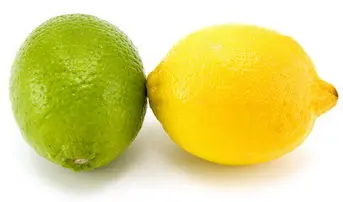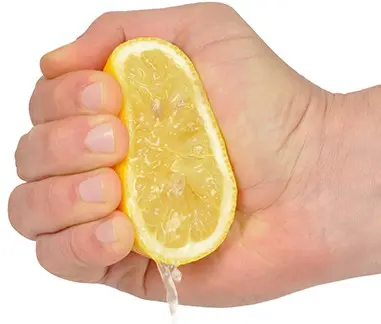Lemon in recipes

Let's take a look at the lemon, yellow or green, which is used in a whole host of recipes, both sweet and savoury. It brings both its taste, and the small acidity that makes its charm. Mind you, I'm not talking about lemon used as an anti-oxidant that prevents it from turning black, or to just spice up the taste of a dish, but as an ingredient in a recipe, like "something with lemon".
16 K 5/5 (14 reviews)
Last modified on: October 23th 2017
Lemon in recipes
In many of these recipes, you very often have two options: zest, or juice, meaning that you use one or the other in the recipe depending on the "tone" you want to give it. Let's say, to simplify things a bit, that when you want the tangy side of the lemon, you use the juice.
And when you want the lemony but more neutral tone, you use the zest.
Well... in principle it makes sense, but in reality it's not really a good practice, because lemon flavours are both complex and at the same time complementary. In fact, you should not limit yourself to one or the other, but try to combine both, both sweet and savoury.
Let's take a savoury example: lemon chicken. There are 36 ways to make it of course, but do you know the one where you simply pan-fry chicken fillets in a little clarified butter and lemon zest, then drizzle lemon juice over them at the end to finish them off by gently caramelising? The mix of the two, zest and juice, will give a very marked "lemon" tone to your chicken, and a great taste!
And a sweet example: the lemon tart. Here too, there are a large number of recipes, personally I am an absolute fan of the sanded pastry + lemon custard, and for the custard, you need to infuse the milk with the zest, and add lemon juice to the custard as soon as it's done cooking. You will also have a very, very marked "lemon" identity, which will have a small effect when tasting.
In summary: In a recipe that uses lemon, always try to use zest and juice.

And when you want the lemony but more neutral tone, you use the zest.

Well... in principle it makes sense, but in reality it's not really a good practice, because lemon flavours are both complex and at the same time complementary. In fact, you should not limit yourself to one or the other, but try to combine both, both sweet and savoury.
Let's take a savoury example: lemon chicken. There are 36 ways to make it of course, but do you know the one where you simply pan-fry chicken fillets in a little clarified butter and lemon zest, then drizzle lemon juice over them at the end to finish them off by gently caramelising? The mix of the two, zest and juice, will give a very marked "lemon" tone to your chicken, and a great taste!
And a sweet example: the lemon tart. Here too, there are a large number of recipes, personally I am an absolute fan of the sanded pastry + lemon custard, and for the custard, you need to infuse the milk with the zest, and add lemon juice to the custard as soon as it's done cooking. You will also have a very, very marked "lemon" identity, which will have a small effect when tasting.
In summary: In a recipe that uses lemon, always try to use zest and juice.
Lasts posts
Butter vs. grease
We often read in a recipe where a pastry is put into a mould that, just before pouring, the mould should be buttered or greased. But what's the difference between these 2 terms?December 1st 20256245
Getting out of the fridge early
Very often when you're cooking, you need to take food or preparations out of the fridge, to use them in the recipe in progress. There's nothing tricky about this: you just take them out of the fridge and use them, usually immediately, in the recipe. But is this really a good method?November 24th 20259415
Who's making the croissants?
When you look at a bakery from the outside, you naturally think that in the bakery, the bakers make the bread, and in the laboratory, the pastry chefs make the cakes. It's very often like that, with each of these professions having quite different ways of working, but sometimes there's also one...November 23th 2025845
Oven height
When we put a dish or cake in the oven, we naturally tend to put it on the middle shelf, and that's what we usually do. But in some cases, this position and height can be a little tricky, so let's find out why.October 8th 20252,4305
The importance of sieving
In recipes that use a fine powder (flour, powdered sugar, etc.), you'll often see the advice to sift before using it. To sift is to pass the powder in question through a sieve (a very fine strainer) before incorporating it into your recipe. It's often advice, but is it really useful?September 3rd 20257,3213
Other pages you may also like
Butter doesn't make you fat, unless you eat too much of it.
Whenever I'm discussing cooking and recipes, there is one idea which comes up frequently, like this: "Oh no! But that's got butter in it" (I should add, for the sake of accuracy, that this is something I hear more frequently from women, who are almost all concerned with keeping their figure). ...March 26th 201245 K4.5
Steam for baking bread
What does steam have to do with bread-making? This is not only a bakers' secret, it is something you might not think of at all: if you make bread and bake it like a cake, you will end up with bread, but pale and with a thick, hard crust – a long way from the golden-brown crusty loaf you had in...June 16th 2021146 K4.5
85 grams of eggs?
Some time ago, I already spoke to you about the difference between baking and pastry-making, I emphasized, among other things, the precision of pastry-making which requires grams, cm, degrees and minutes. That's why, on the one hand, you have baking and cooking, where a certain tolerance is...November 26th 201856 K4.6
The baker always gild twice
I've already told you about gilding, the beaten whole egg that is spread with a brush on anything that needs to brown in the oven: puff pastry, pastries, etc. and that professionals use a lot, I'm going to come back to this to clarify a bit how to do it, and give you a professional tip.June 9th 201935 K4.2
Cutting soft cheeses
As you may have already noticed, when you have to use a "soft" cheese in a recipe - their exact name is "soft cheese" - such as Camembert, Munster or Mont d'or, it's not easy to make anything other than thick slices.February 20th 20249,4285
Post a comment or question
Follow this page (as 2 people already do)
If you are interested in this page, you can "follow" it, by entering your email address here. You will then receive a notification immediately each time the page is modified or a new comment is added. Please note that you will need to confirm this following.
Note: We'll never share your e-mail address with anyone else.
Alternatively: you can subscribe to the mailing list of cooling-ez.com , you will receive a e-mail for each new recipe published on the site.









